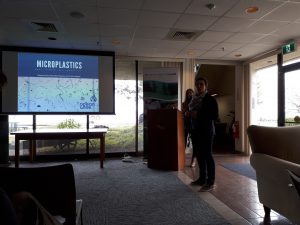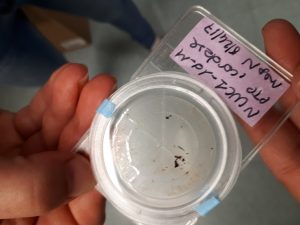A series of interesting talks and walks where had at EMA’s visit to the Fisheries and Oceans Canada facilities.
Here are the highlights:

Presentation
Ocean Wise Researcher, Rhiannon Moore, gave a presentation about microplastics. Microplastics are plastics less than 5mm in size. They circulate in ocean and freshwater systems. There are primary microplastics, such as nurdles and microbeads (e.g. in exfoliating soap), and secondary microplastics composed of either the breakdown of larger plastics or microfibers (e.g. from synthetic clothing). Plastics do not biodegrade; instead breaking into smaller and smaller pieces. Microfibers in wash water from the washing machine are observed in water, sediment, fish, birds, bivalves, and marine mammals. Plastics move around the ocean through currents because they are lightweight and durable.
How does plastic bioaccumulate in the Food Web? Research by the Ocean Wise on microplastics is being conducted to assess this: Zooplankton in the Western Canadian Arctic, blue mussels on the BC Coast, Wastewater and biosolids (in collaboration MetroVancouver), Laundry effluent shed rates (in collaboration with MEC, Arcteryx, Patagonia, REI), Beluga Food Web in the Beaufort Sea.
Project: Beluga Food Web in the Beaufort Sea – plastic bioaccumulation
Step 1 – Dissection
Step 2 – Digestion in enzyme or base
Step 3 – Filtration
Step 4 – Microscopy and counting of microplastics
Final Step – Fourier-Transform Infrared Spectroscopy (FTIF) to confirm if particles are plastic and what type. This machine can hint at the origins of the plastics.
In the Pacific Northeast Ocean of BC, the concentration of microplastics is between 8-9200 particles/m3. Microfibers account for 75% of these particles. In Coal Harbour, water samples average 1258 particles/m3.

Goal – to connect research with actual solutions. One example of this is the Ocean Wise campaign to reduce plastic use.
Tour Stop #1:
Ocean Wise Mussel Lab – they are counting microplastics in the waste of mussels that they feed to assess the input/output ratios.
Tour Stop #2:
Ocean Wise DNA Lab – they are examining the bioaccumulation of chemicals, such as PCBs, in beluga whales and harbor seals. PCBs have decreased since they were regulated in the 1970s, but the decrease plateaued, and now PCBs circulate in a steady state, with deposits of high/low concentrations dependent on ocean circulation patterns.
Tour Stop #3:
Fisheries and Oceans Canada Salmon Lab
There are different types of selection on natural fish. Genetic selection due to selection by hatcheries is one example.
There are also genetically engineered fish, which are fish that have had a gene modification. Canada is the first and only country to have permitted genetically engineered fish in the human food chain. These fish have had their growth hormone expression gene modified to produce larger fish.
Questions: What happens when genetically engineered fish are deployed in nature? What are the potential effects to the natural environment? There is potential to affect the survival and reproduction of natural fish if they escape into nature. Because the outcome is largely unknown, genetically engineered fish are relegated to land tanks.
Data – after 1 year, the grown rate is 35 times higher than natural fish. Genetically engineered fish are larger. When placed in: 1) tanks with natural smaller fish of the same age, fewer smaller fish survive because they are cannibalized by the larger genetically engineered fish; 2) simulated natural environment, fewer genetically engineered fish survive than their natural counterparts because of predators, stream forks, and natural obstacles. The engineered fish are programmed to find food and grow, and because of this, their behavior differs from natural fish, and they are mainly focused on feeding.
Recommendations – Genetically engineered fish should exist on secured land-based facilities only, where there is no chance of escape into the wild because the effects of them in nature are not yet known.

Tour Stop #4: Nutrition Lab – What are alternative feed and feed ingredients for salmon that are less environmentally impactful? Canola, Camolina, and Bone Meal are being tested. The goal is to find alternative protein and oils to be less reliant on the ocean for salmon food, as our need for lower trophic fish to make fish food exceed the natural supply due to farming of fish.
They have a pellet mill on premises to feed and assess fish. Experiment with Arctic Char photographed in white buckets.

Tour Stop #5: Salmon Sea Lice Lab – what are alternate biological ways to treat sea lice in farmed salmon?
Options: Pile Perch or Kelp Perch. So far, it seems Pile Perch are the best way, but what size, how many, and what environmental conditions are most beneficial? Also, how should the perch be fed in a commercial setting? How will they affectively stock perch for large commercial pens? Can perch carry diseases that will transfer to salmon? Experiments are being conducted to address these questions. GoPro cameras are used to see if perch eat the sea lice in fish that have been given lice. They also dissect perch feces to count lice.
Thank you to the Coastal Ocean Researchers and to the tour participants for making this an informative and fun outing!